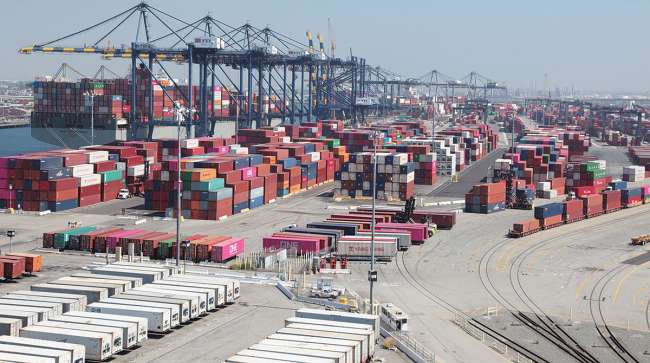Senior Reporter
Port Officials, Retailers See Congestion Lasting for Months

[Stay on top of transportation news: Get TTNews in your inbox.]
During the COVID-19 pandemic, sales of Peloton exercise bikes and other equipment have surged as the New York City-based exercise company saw its membership subscriptions reach more than 3.1 million, more than double the number of subscriptions compared with 2019, as people have avoided their local gyms and turned to exercising at home.
But long delays at the nation’s ports to get items shipped and unloaded are causing Peloton and other companies to rethink their long-term strategies about where its equipment is manufactured and how products get to customers.
Most of Peloton’s equipment is built in Taiwan and shipped on conventional sea routes to distribution centers worldwide. In part because of shipping concerns, Peloton in late 2020 purchased Precor, a gym-equipment manufacturer, and added 650,000 square feet of manufacturing space at locations in Whitsett, N.C., and Woodinville, Wash.

Foley
“You may have read about the port congestion in Los Angeles and Long Beach, where shipping container volume has doubled in the last 12 months,” Peloton CEO John Foley said in a Feb. 4 letter to shareholders. “The global increase in shipping traffic has added significant delays to all sorts of goods coming into U.S. ports, including Peloton products.
“These unpredictable delays have resulted in painful delivery reschedules for many people as Peloton bikes, treads and accessories have been held at port for upwards of five times longer than usual.”
The company took the unusual step of shipping some equipment by air cargo, but Foley says the costs impact Peloton’s bottom line.
“On average, in the coming months, we will be incurring a transportation and delivery cost that is over 10 times our usual cost per bike and tread, including, in many cases, shipping them by air instead of by sea,” Foley said.

Fleets are investing in tech-based safety tools that inform and forewarn potential risk. But how do they condition and prepare drivers to respond to safety alerts? Find out as the RoadSigns Team speaks with Tom DiSalvi, VP of safety at Schneider National, and Charlie Mohn, director of product innovation at Drivewyze. Hear a snippet, above, and get the full program by going to RoadSigns.TTNews.com.
Peloton’s concerns about shipping backlogs are not unusual. Several companies, including athletic shoe retailer Foot Locker and Overstock.com, are rerouting cargo to other ports, including Seattle and Oakland, and away from Southern California because of the backlog.
Congestion is not as severe at East Coast facilities. Still, many reported record container volume in the last quarter of 2020 and the first months of this year.
Port leadership, industry experts and government officials are becoming increasingly concerned the huge facilities are likely to remain extremely congested for the next six months. Factors include a flood of products from Southeast Asian factories, a percentage of longshoremen being off the job because of COVID-19 and a shortage of warehouse space nationwide, especially near ports.
At San Pedro Bay, the entrance to the ports of Los Angeles and Long Beach, 46 cargo ships were waiting to enter the facilities March 8.
“When a container is waiting at a warehouse, it’s now sitting for about eight days. And that’s usually three and a half days during pre-pandemic times,” Port of Los Angeles Executive Director Gene Seroka said. https://t.co/DIw3KQJ8uT — Port of Los Angeles (@PortofLA) March 8, 2021
“It’s pretty heavy. If we stopped bringing in cargo right now, we’d have a month’s worth of work ahead of us,” Port of Los Angeles Executive Director Gene Seroka told Transport Topics. “We must vaccinate all of our port workers as quickly as possible. There are about 100,000 people who work at this port complex every day, and we have a lot of people we have to maintain health and safety to keep the economy running.”
Seroka said more longshoremen are returning to work after being vaccinated, quarantined or declared virus-free or contracting COVID-19 and recovering.
As recently as March 1, 10% of the skilled longshoremen at the Port of Los Angeles — about 800 workers —were unavailable.
On March 8, Federal Maritime Commission members Daniel Maffei and Carl Bentzel wrote the eight Great Lakes states’ governors urging them to give COVID-19 vaccine priority to maritime workers.
In late January, they sent a similar letter to President Joe Biden urging longshoremen to get shots as soon as possible because of the vital role they have in moving cargo.
FMC Vaccination Letter to Biden by Transport Topics on Scribd
Meanwhile, the National Retail Federation said March 8 that imports will surge on both coasts, causing more backlogs as the U.S. economy is expected to improve.
“NRF is forecasting what could turn out to be record retail sales growth in 2021, and retailers are importing huge amounts of merchandise to meet the demand,” said Jonathan Gold, NRF vice president for supply chain and customs policy. “The supply chain slowdown we usually see after the holiday season never really happened this winter, and imports are already starting to grow again.”
NRF is forecasting what could turn out to be record retail sales growth in 2021.
National Retail Federation Vice President Jonathan Gold
IHS Markit Transportation Economist Paul Bingham told TT that delays would continue until more workers are vaccinated.
“The workforce itself has been stressed, whether it’s the dray truck drivers or the longshore workers or all the others in the supply chain. They’ve all been whipsawed,” he said. “How long do the restrictions on operations and the social distancing last? That could be quite a while.”
Want more news? Listen to today's daily briefing below or go here for more info:

